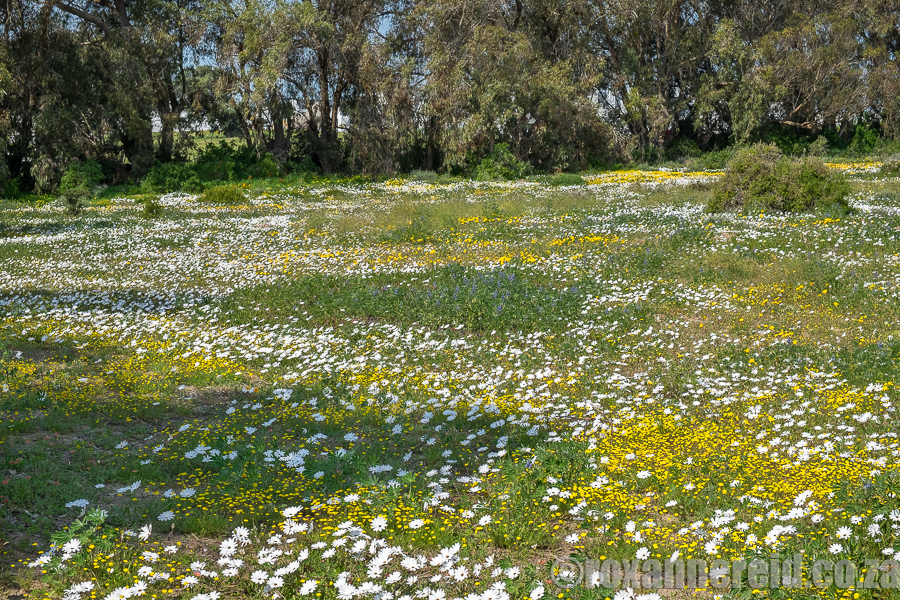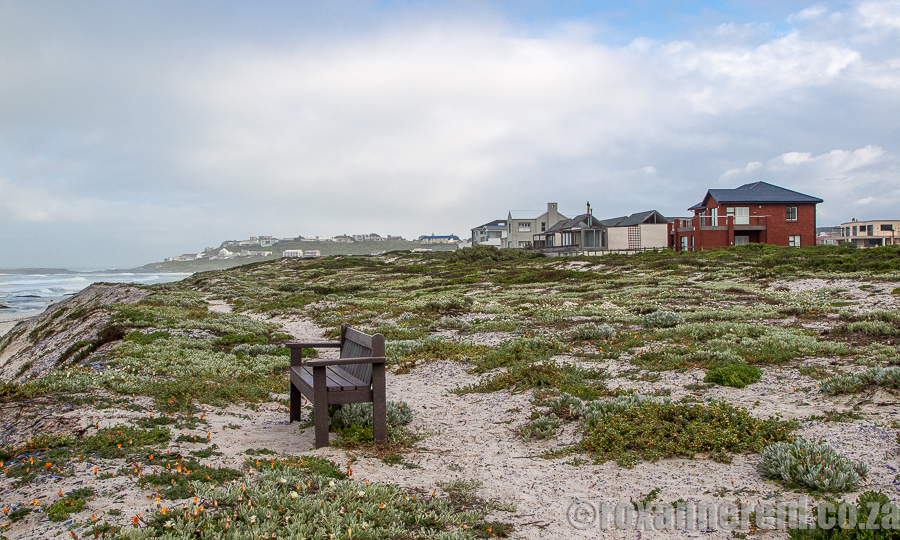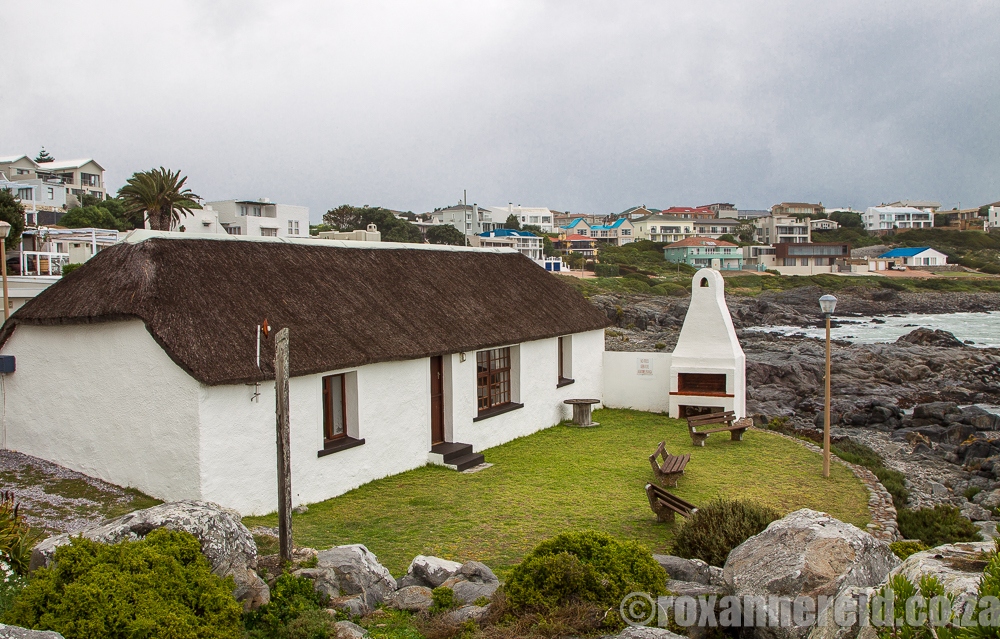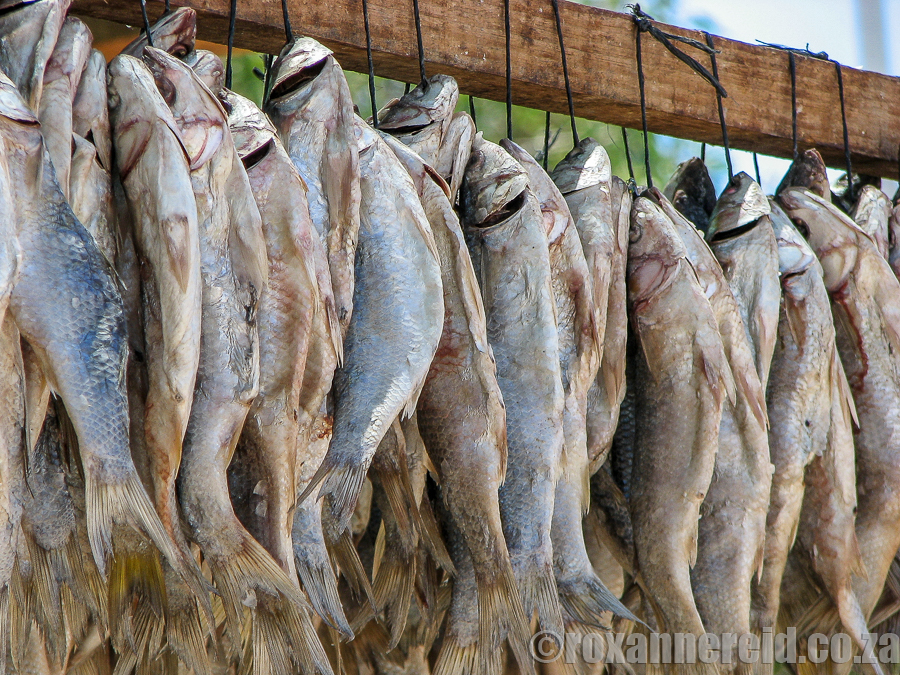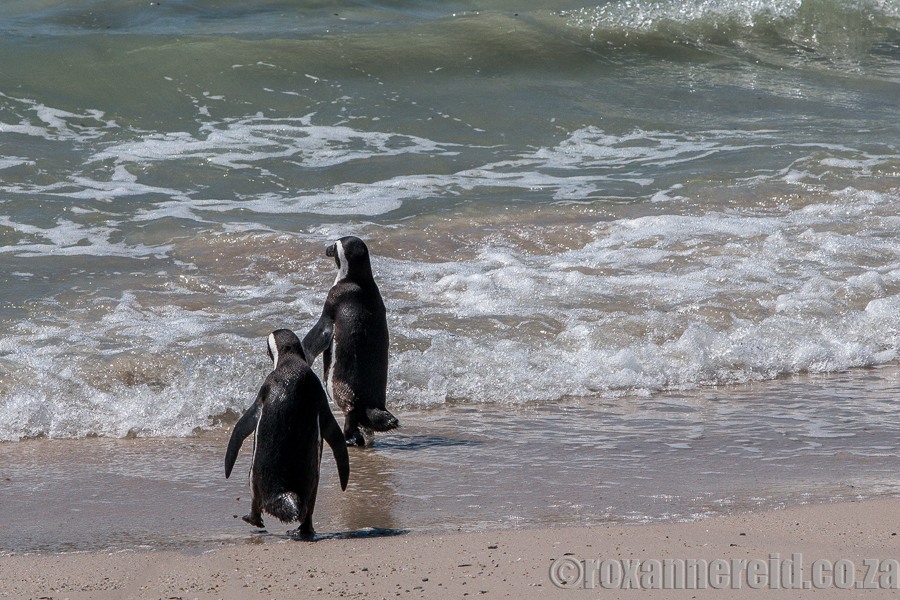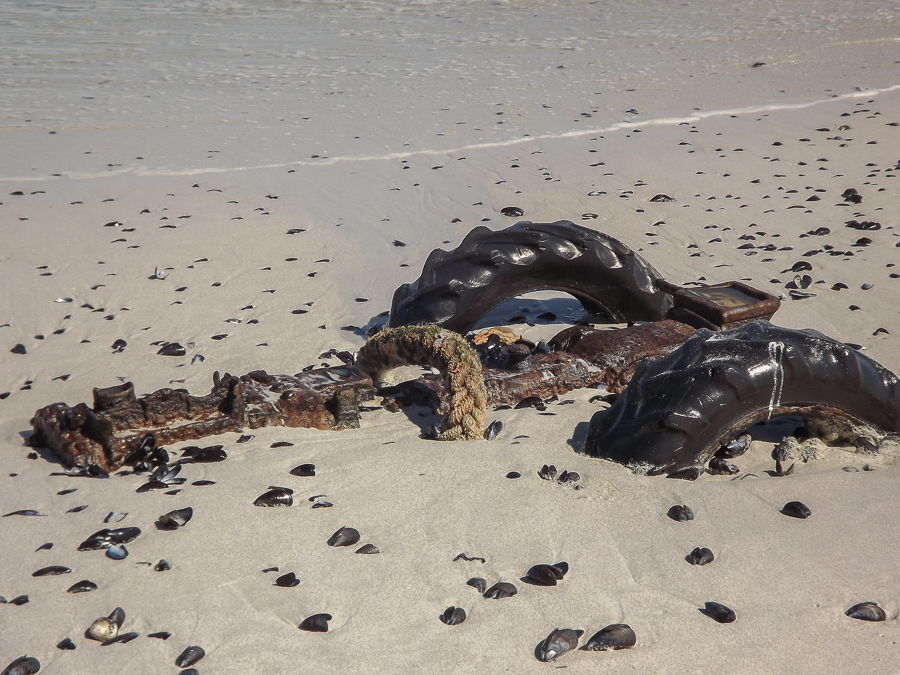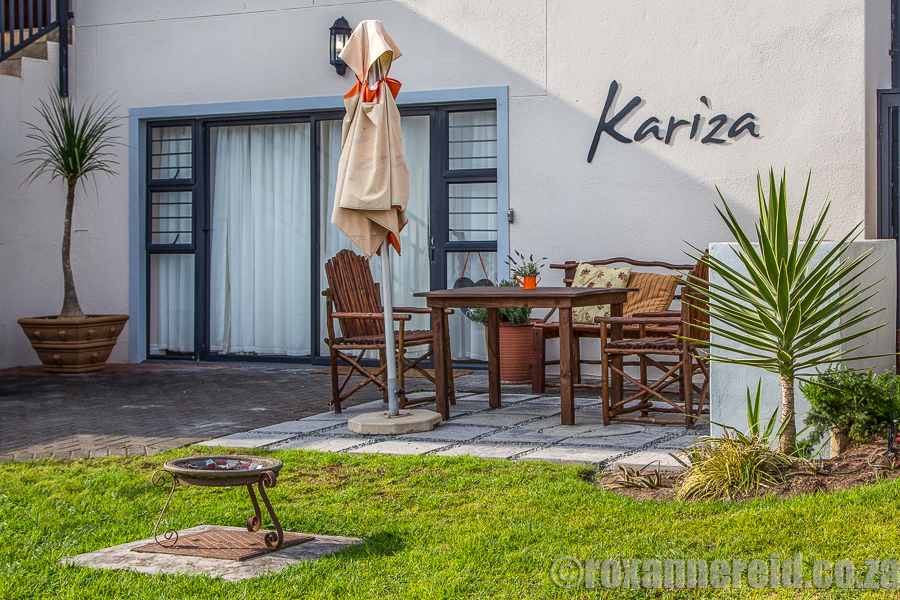
By Roxanne Reid
The seaside town of Yzerfontein on the West Coast Way is about an hour’s drive north of Cape Town along the R27. Nature is a strong draw card, from bird life and indigenous plants to 16 Mile Beach which stretches to the West Coast National Park. The town is also a hub for fishermen and sporty types going surfing, mountain biking or kite-surfing. But here are 10 things you may not know about Yzerfontein.
The seaside town of Yzerfontein on the West Coast Way is about an hour’s drive north of Cape Town along the R27. Nature is a strong draw card, from bird life and indigenous plants to 16 Mile Beach which stretches to the West Coast National Park. The town is also a hub for fishermen and sporty types going surfing, mountain biking or kite-surfing. But here are 10 things you may not know about Yzerfontein.
1. Spring flowers
Namaqualand and the Postberg Section of the West Coast National Park are probably more famous for their spring flower displays, but Yzerfontein is no slouch. If you visit in spring, stop just outside town on the R315 to admire fields packed with white and yellow flowers. In the Pearl Bay area we watched an ostrich with three chicks stroll down the street, snacking on wild flowers that grow in profusion thanks to the Yzerfontein Urban Conservancy.
2. Urban Conservancy
2. Urban Conservancy
The Yzerfontein Urban Conservancy is a voluntary organisation that looks after nature in the town. About 127ha of Yzerfontein is green belt that’s part of a local area nature reserve owned by the Swartland municipality. ‘We and nature are interdependent,’ says conservancy chairman Ben Tromp. ‘We rely on it for air, water and food and must live in balance with it. Here nature also gives economic opportunity through tourism.’
Some of the conservancy’s current projects are eradicating aliens, rehabilitating dunes, an indigenous demo garden (with endemic and indigenous plants to inspire local gardeners and warn them how aliens can seed in green belt areas), toxic waste disposal (think electronic waste, batteries, light bulbs) and coastal/beach hygiene.
They also built a labyrinth on Atlantic Drive in Pearl Bay where you can go to chill and appreciate nature and sea views. ‘The challenge now is to create awareness and we’re working with the municipality to identify public access points where we can put up information posters,’ says Ben.
Some of the conservancy’s current projects are eradicating aliens, rehabilitating dunes, an indigenous demo garden (with endemic and indigenous plants to inspire local gardeners and warn them how aliens can seed in green belt areas), toxic waste disposal (think electronic waste, batteries, light bulbs) and coastal/beach hygiene.
They also built a labyrinth on Atlantic Drive in Pearl Bay where you can go to chill and appreciate nature and sea views. ‘The challenge now is to create awareness and we’re working with the municipality to identify public access points where we can put up information posters,’ says Ben.
3. History and an island of sheep
Archaeological digs in Yzerfontein have found remains of food and tools left by ancient people who lived here long, long ago. The history of Dutch settlement began in 1732 when Cornelius Heufke got permission to graze his livestock on a farm that was then called Eijzerfontein (the name deriving from the iron deposits in the drinking water). By 1915 it was owned by Nicolas Pienaar. In 1937 Pienaar kept one piece of his farm and sold off the rest to other families and to Yzerfontein Seaside Estates. It was declared a village in 1937 – so it celebrates its 80th anniversary in 2017.
In the 1920s there were only five houses at Yzerfontein. Back then it was a popular place for inland farmers to come for a camping holiday by the sea. ‘In fact, Schaap Island got its name because farmers who holidayed at the beach used to bring all their own supplies, like a cow for milk, hens for eggs, and so forth,’ says Leané Koegelenberg of Yzerfontein Tourism. To keep their sheep [schaap in Dutch] safe from jackals they’d put them on the island, which was cut off from the mainland at high tide.
4. Cement made from mussel shells
Archaeological digs in Yzerfontein have found remains of food and tools left by ancient people who lived here long, long ago. The history of Dutch settlement began in 1732 when Cornelius Heufke got permission to graze his livestock on a farm that was then called Eijzerfontein (the name deriving from the iron deposits in the drinking water). By 1915 it was owned by Nicolas Pienaar. In 1937 Pienaar kept one piece of his farm and sold off the rest to other families and to Yzerfontein Seaside Estates. It was declared a village in 1937 – so it celebrates its 80th anniversary in 2017.
In the 1920s there were only five houses at Yzerfontein. Back then it was a popular place for inland farmers to come for a camping holiday by the sea. ‘In fact, Schaap Island got its name because farmers who holidayed at the beach used to bring all their own supplies, like a cow for milk, hens for eggs, and so forth,’ says Leané Koegelenberg of Yzerfontein Tourism. To keep their sheep [schaap in Dutch] safe from jackals they’d put them on the island, which was cut off from the mainland at high tide.
4. Cement made from mussel shells
Look out for the two historic lime kilns on the R315 before you enter Yzerfontein. Their story is fascinating. When a refreshment station was established at the Cape of Good Hope, there was no cement for building. So the Dutch built lime kilns to burn mussel shells. The ash was raked out and had a triple use: mixed with water to make cement, with salt to make whitewash to paint buildings, and with animal fat to make walls waterproof. The Castle in Cape Town and many farm houses in the Sandveld were built with cement made from Yzerfontein mussel shells – how’s that for ingenious? The kilns were still in use as recently as 1976 and there’s a scaled-down reproduction of one of them in the grounds of the tourism office.
5. Salt pans, bokkoms and the oldest building
5. Salt pans, bokkoms and the oldest building
Yzerfontein’s salt pans used to be in hot demand and you can still see the remains of the harbour built in 1911 for shipping salt to Cape Town. The oldest building in Yzerfontein, the thatched Vishuis – now the tourism office – was used to store the salt. Harders were also dried and salted here to make bokkoms for sale to local farmers. Photos inside the tourism office show that the building was fenced during World War II, and you can still see one of the wooden fence poles in a rock on the sea side of the building.
A couple called Pieters restored the building in the 1970s and used it as a holiday home. It became a municipal building in 1989 and the tourism office in 2002. So many stories these thick old walls could tell.
A couple called Pieters restored the building in the 1970s and used it as a holiday home. It became a municipal building in 1989 and the tourism office in 2002. So many stories these thick old walls could tell.
6. Radar station ‘manned’ by women
During World War II Yzerfontein had a radar station, erected in March 1943. It was run by six women whose job was to track enemy ship and air traffic and especially to look out for enemy submarines threatening the Allied shipping and troopship convoys. Air combat pilots from up north recuperated at an air school in Darling and occasionally used to visit for a swim or a party. Someone later built a house on the foundations of the radar station.
7. Penguin plunder at Dassen Island
During World War II Yzerfontein had a radar station, erected in March 1943. It was run by six women whose job was to track enemy ship and air traffic and especially to look out for enemy submarines threatening the Allied shipping and troopship convoys. Air combat pilots from up north recuperated at an air school in Darling and occasionally used to visit for a swim or a party. Someone later built a house on the foundations of the radar station.
7. Penguin plunder at Dassen Island
In the 1960s and 1970s, some 600 000 penguin eggs were removed for eating from Dassen Island, which is about 10km west of Yzerfontein in the Atlantic Ocean. Tons of guano was also removed for use as fertiliser. Populations of the African penguin have plummeted as a result of habitat modification of nesting sites, oil spillages and competition for food with commercial fishing. The African penguin is now classified as Endangered by the IUCN Red List and listed on Appendix II of the CITES (Convention on International Trade of Endangered Species).
Luckily Dassen Island was declared a nature reserve in 1987 and is now managed by CapeNature, mainly to protect its seabirds.
8. Tractor buried on the beach
Luckily Dassen Island was declared a nature reserve in 1987 and is now managed by CapeNature, mainly to protect its seabirds.
8. Tractor buried on the beach
Yes, that’s right, a tractor is buried on the beach at Pearl Bay. The story goes that round about 1979 a car got stuck on the beach and the tractor came to its rescue. It pulled the car out successfully but then got stuck itself. Apparently it still sometimes reappears depending on how low the tide is and how rough the seas. ‘I’ve lived in the area all my life and never seen it,’ says Leané Koegelenberg of Yzerfontein Tourism. ‘But then someone sent me some photos so I’ve seen proof that it’s there.’
9. Yzerfontein has a ghost
One of the five original houses in Yzerfontein, the Langhuisie, which belonged to the Schreuders, is the setting for a ghost story about a man who lost his head. A widower called Rosenleft, the story goes, used to visit Mrs Schreuder when her husband was away and concocted a plan to murder him. One of her daughters overheard the plan and told her father, who changed his will in her favour.
One day Schreuder went fishing with a buddy. He disappeared and the buddy’s body washed up with the telltale blue marks of strangulation around his neck. The murderous Rosenleft told Mrs Schreuder he’d killed her husband but she didn’t believe him. So he went back to the body, cut off the head and brought the grisly trophy to her. Some people think they later put the head in the outside loo, while others believe he burnt the body in the lime kiln. Langhuisie is said to be haunted by the ghost of the man who lost his head.
10. You can get almost anything here if you know who to ask
9. Yzerfontein has a ghost
One of the five original houses in Yzerfontein, the Langhuisie, which belonged to the Schreuders, is the setting for a ghost story about a man who lost his head. A widower called Rosenleft, the story goes, used to visit Mrs Schreuder when her husband was away and concocted a plan to murder him. One of her daughters overheard the plan and told her father, who changed his will in her favour.
One day Schreuder went fishing with a buddy. He disappeared and the buddy’s body washed up with the telltale blue marks of strangulation around his neck. The murderous Rosenleft told Mrs Schreuder he’d killed her husband but she didn’t believe him. So he went back to the body, cut off the head and brought the grisly trophy to her. Some people think they later put the head in the outside loo, while others believe he burnt the body in the lime kiln. Langhuisie is said to be haunted by the ghost of the man who lost his head.
10. You can get almost anything here if you know who to ask
According to local resident Karen Schräder, Yzerfontein is a peaceful town where the best thing to do is appreciate nature. ‘They say adventure isn’t new things but seeing things with new eyes,’ she says. ‘Walk on the beach, go to the harbour, take a picnic basket and look at the flowers.’ Picnic basket? Oh yes, she can hook you up. Want to hire a surf board? She knows a guy. In fact, she has the inside scoop on whatever you’re looking for.
We were lucky to have access to this insider info when we got chatting to Karen during our stay at her Kariza self-catering apartment. It was light and airy, had everything we needed for self-catering, and enjoyed a sea view as a bonus. In the newer Pearl Bay section of Yzerfontein, it looked out over open green belt and was just a short way from long walks on the beach.
Yzerfontein Tourism’s Leané Koegelenberg is also a great source of information on the town, particularly its history and things to do.
Copyright © Roxanne Reid - No words or photographs on this site may be used without permission from roxannereid.co.za
Yzerfontein Tourism’s Leané Koegelenberg is also a great source of information on the town, particularly its history and things to do.
Copyright © Roxanne Reid - No words or photographs on this site may be used without permission from roxannereid.co.za
Find the article interesting? Pin this image!
